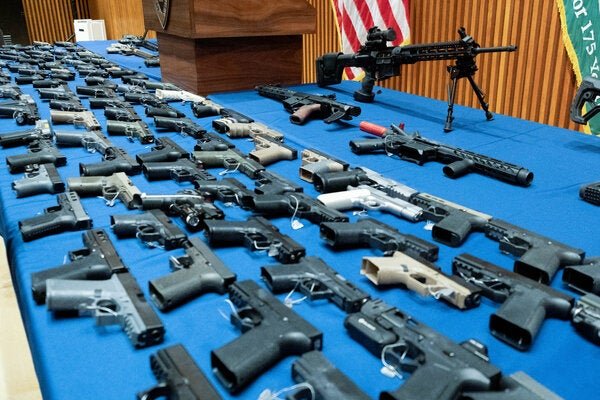By Rebecca Valek, Cassandra Crifasi, and Alex McCourt
Gun violence rates in the U.S. have reached all-time highs in recent years.1 Overall, in 2022, more than 48,000 Americans died by guns.2 Since 2019, the rate of gun deaths in the U.S increased 21%.3 These increases in gun deaths have especially impacted young Americans.4 Between 2013 and 2022, rates of gun deaths among children and teens increased 87%.5 Nearly 4,600 American youth (aged 1–19) were killed by guns in 2022, fueled by increases in both homicide and suicide.6 Increased deaths have prompted Americans to call for legislative action.7 Despite the growth in dissatisfaction with U.S. gun laws and high levels of support for stricter gun legislation, some gun laws have become more permissive in the past two decades, particularly in states with Republican majorities.8 Supreme Court decisions have accelerated this shift, beginning with District of Columbia v. Heller in 2008, which expanded the understanding of the Second Amendment to include an individual right to own handguns for self-defense, and McDonald v. City of Chicago in 2010, which held that the Second Amendment applies to state and local governments.9 These decisions, along with the 2022 decision preventing states from requiring proper cause to obtain concealed carry licenses in New York State Rifle & Pistol Association Inc. v. Bruen, have expanded gun rights and limited the abilities of state legislatures and Congress to regulate gun violence.10 John Feinblatt, president of the nonprofit gun violence prevention advocacy group Everytown for Gun Safety, described the Bruen decision as “out of step with the bipartisan majority in Congress that is on the verge of passing significant gun safety legislation, and out of touch with the overwhelming majority of Americans who support gun safety measures.”11 At a time when gun violence has become the leading cause of death of Americans under 20 years old, the successful enactment and implementation of such highly supported policy is essential.12 Public opinion can directly affect legislative and executive actions and, while the effect on the judiciary may be less clear, there is often a connection between public opinion and court decisions.13 Many scholars have noted a significant influence of public mood and public opinion on the decisions of the Supreme Court.14 The Supreme Court’s sociological legitimacy, a term used by legal scholars to refer to the public’s view and respect of the Court, depends largely on the extent to which the Court’s decisions align with public opinion.15 When the Court’s decisions are affected by public opinion to promote sociological legitimacy, the Court’s legal legitimacy — or its Justices’ consistent application of their preferred approach to interpreting the law — may be diminished.16 In Bruen, the majority of the justices adopted an approach that uses elements from originalism and textualism without adhering completely to either.17 The Bruen standard requires courts to evaluate gun laws by looking to text, history, and tradition to determine whether the law at issue is “consistent with the Nation’s historical tradition of firearm regulation.”18 To date, very few courts have evaluated age-restrictive gun laws, but legislatures continue to adopt new gun laws and courts, including the Supreme Court, are hearing new Second Amendment-related challenges.19 Public opinion will play a role in this process. The views of the public — both nationwide and in specific constituencies — may affect what gun policies are introduced and enacted by legislators, what laws are challenged in court, and what decisions courts reach in those challenges. In addition, as courts continue to grapple with Bruen and its standards, public opinion — whether historical or modern — may shape how judges think about history and tradition. Age-related gun laws may be of particular interest as rates of gun violence among youth have elevated and government officials evaluate existing laws and explore new laws in their search for solutions.
United States, Fordham Urb. L.J. 117. 2023, 40pg



